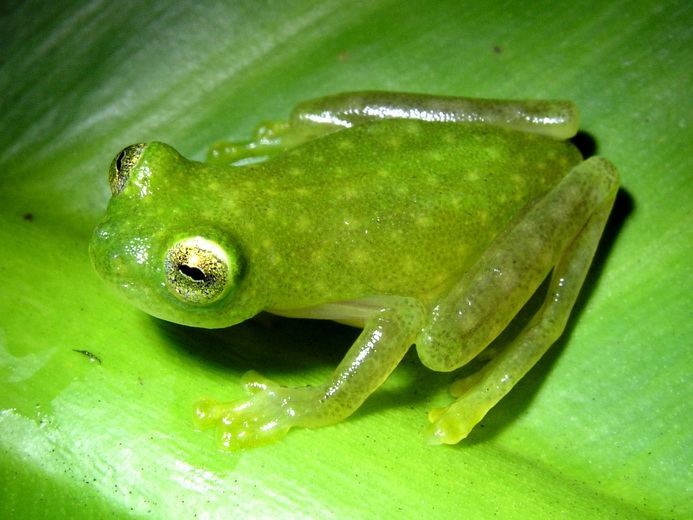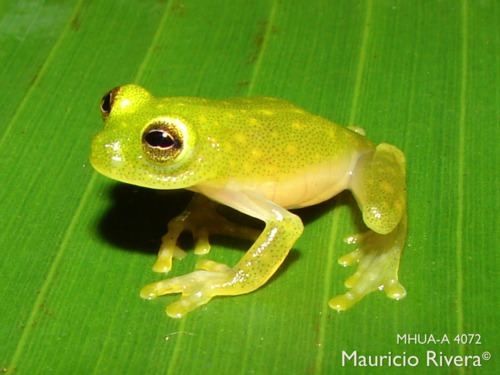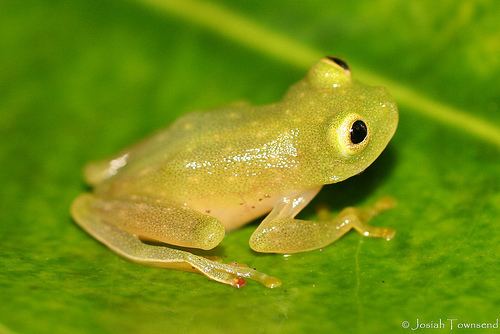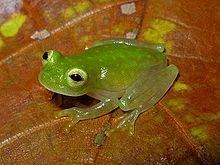Order Anura Rank Species | Phylum Chordata Family Centrolenidae Higher classification Hyalinobatrachium | |
 | ||
Scientific name Hyalinobatrachium fleischmanni Similar Frog, Glass frog, Hyalinobatrachium, Amphibians, Centrolene | ||
Hyalinobatrachium fleischmanni
Hyalinobatrachium fleischmanni, the Fleischmann's glass frog or northern glass frog, is a species of frog in the Centrolenidae family. It is found in the tropical Americas from southern Mexico to Ecuador. Specifically, these frogs occur in Mexico, Belize, Costa Rica, El Salvador, Guatemala, Honduras, Nicaragua, and Panama, Colombia, and Ecuador. Notice that this and related species have often been confused with each other, and the exact distribution depends on the source.
Contents
- Hyalinobatrachium fleischmanni
- Hyalinobatrachium fleischmanni rana de crista de fleischman macho cantando
- Etymology
- Description
- Habitat
- Breeding
- References

Hyalinobatrachium fleischmanni rana de crista de fleischman macho cantando
Etymology
The specific name fleischmanni honors Carl Fleischmann, a collector in Costa Rica in the 1980s.
Description

Glass frogs have similarities to tree frogs. They look very close to the naked eye except glass frog's eyes point forward and are golden. During the day, these frogs camouflage themselves under leaves but above water. Male glass frogs are 19–28 mm long while females measure from 23–32 mm long. They have a green semi-translucent color with yellow translucent hands. Their skin has dots which matches that of the leaves in the area. When confronted or approached, they tend to freeze up and not move. It is not specifically known what the glass frog eats, but it is assumed that they feed on small insects.

Also known as the Northern Glass Frog, this frog’s physical features include primarily green skin, pale yellowish spots, yellow fingertips and translucent skin covering its stomach. A sheet of guanine stretches over several internal organs, such as the heart, but leaves others parts such as the liver exposed for viewing as it only covers half of the frog’s underbelly. They also possess a white vocal sac that can be used to produce sounds for mating. Male frogs have a noticeable hook protruding from its spine, presumably used to fight other frogs, defend its territory or the eggs. They are fierce fighters who will occasionally engage in a wrestling match with other intruding frogs. The female species are slightly larger and lacks this particular feature. There have been more than 100 reported glass frogs throughout Central and South America. 13 species can be found in Costa Rica. Adults tend to be more active during the night when there is rain to keep their skin moist and from drying out. However, strong rains can kill them because their bodies are so fragile. A simple direct shot from a raindrop has been known to kill a glass frog.
Habitat

Fleischmann's Glass Frogs live near fast streams. In Costa Rica, these frogs live in lowland wet forests, rain forests, and even in higher elevations. They do not like dry areas such as the northwestern lowlands, high mountains, or coasts. Of all the glass frogs in Costa Rica, Fleischmann's glass frogs are the most populous. The glass frogs are also arboreal, which means they reside in trees. These frogs tend to lay their eggs on lower branches, the bottom of leaves and near flowing water. About 18–30 eggs could be laid, and the male frog would stand guard over the eggs to protect them from predators until they hatch, and the tadpoles drop into the water. During mating season, the males would call out to the females, and once a relationship has been established, the highly territorial males would display another call to warn competitors away. Should any potential threats not back away, the frogs would fight until a winner is determined. The victor would be able to reproduce with the female.
Breeding

The glass frog’s reproduction cycle beings during the rainy season, and is sometime between May to October. The number of eggs is dependent on the time of year they are laid. A large number of the egg’s natural predators means that roughly 80% of the clutches are eaten and/or destroyed. The male frog takes precautions to keep his eggs safe, such as defending them, or urinating on the eggs to ensure that they do not dry out. The eggs hatch after approximately 10–15 days. The tadpoles that fall into the water usually remain hidden in debris at the bottom of the stream. Their growth is time-consuming, and it takes between 1–2 years for the tadpoles to fully mature.

Some risks the eggs face are infections by fungus, or being eaten by larger predators such as crickets and possums.

